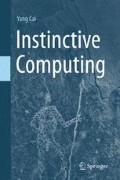Abstract
According to ethnologists, humans are simply survival machines programmed to preserve and replicate our genes. In order to secure this process, we have developed self-awareness to identify ourselves and to avoid life-threatening situations at multiple levels, from our cells to our existence as organisms. In this Chapter, we explore self-defense systems in nature and cyberspace, the behavioral models of malicious programs, biomorphic defense models, and collective consciousness in the Internet of Things.
Access this chapter
Tax calculation will be finalised at checkout
Purchases are for personal use only
Notes
- 1.
Dawkins R (1976) The selfish gene. Oxford University Press.
- 2.
Ouellette J (2014) Ten things I learned about me. Slate, posted on January 30, 2014. http://www.slate.com/articles/health_and_science/science/2014/01/the_science_of_the_self_what_can_neuroscience_and_psychology_tell_us.html
- 3.
Gregory RL and Gombrich EH, eds. (1973) Illusion in nature and art. Charles Scribner’s Sons, New York.
- 4.
Hawking S. Life in the universe. hawking.org.uk. http://www.hawking.org.uk/life-in-the-universe.html
- 5.
Dzhagalov et al. (2013) Negative selective T. Accessible Bioscience. http://accessiblebiosci.blogspot.com/2013/08/negative-selectivi-t-dzhagalov-et-al.html
- 6.
Toon J (2011) How T cell recognize the bad guys. Futurity, Jan. 24, 2011. http://www.futurity.org/how-t-cells-recognize-the-bad-guys/
- 7.
Jian N, Huang J, Edward LJ, Liu B, Zhang Y, Beal CD, Evavold BD, Zhu C (2011) Two-stage cooperative T cell receptor-peptide major histocompatibility complex-CD8 trimolecular interactions amplify antigen discrimination, Journal of Immunity, vol. 34, No. 1, p13–23, January 2011.
- 8.
Forrest S and Perelson AS (1994) Self-nonself discrimination in a computer. Proceedings of IEEE Computer Society on Research on Security and Privacy, 1994.
- 9.
Dasgupta D and Forrest S (1998) An anomaly detection algorithm inspired by the immune system. In Dasgupta D. (ed.). Artificial Immune Systems and Their Applications. Springer.
- 10.
Forrest S, Javornik B, Smith R and Perelson AS (1993) Using genetic algorithms to explore pattern recognition in the immune system. Evolutionary Computation, vol.1, no. 3, pp.191–211, 1993
- 11.
Dasgupta D. An overview of artificial immune systems and their applications. In Dasgupta D, eds. (1998) Artificial Immune Systems and Their Applications. Springer 1998
- 12.
Christopher D. Lynn et al. (2016) Tattooing to “Toughen up”: Tattoo experience and secretory immunoglobulin A, American Journal of Human Biology. March 4, 2016.
- 13.
University of Alabama in Tuscaloosa (2016) Want to avoid a cold? Try a tattoo or twenty, says researcher. Medical Press. Online post on March 9, 2016. http://medicalxpress.com/news/2016-03-cold-tattoo-twenty.html
- 14.
Gallup GG, Anderson JR, and Shillito DJ (2002) The mirror test. In Bekoff B et al. (eds). The Cognitive Animal. The MIT Press, 2002.
- 15.
CycleFish.com. What gives a Harley-Davidson its unique sound? Posted on August 4, 2011. http://www.cyclefish.com/RoadCaptain/blog/1311/
- 16.
McGehee F (1937) The reliability of the identification of human voice. J. of Psychology, vol. 17, pp. 249–271, 1937.
- 17.
AP Press (2007). Alleged drug kingpin with altered face arrested, August 10, 2007. http://www.nbcnews.com/id/20217024/ns/world_news-americas/t/alleged-drug-kingpin-altered-face-arrested/#.VvycZ7RMLMU
- 18.
Atal BS (1976) Automatic recognition of speakers from their voices. Proceedings of IEEE, vol. 64, no. 4 April, 1976
- 19.
Cai Y, Li X, Gong ZJ, Codina TR (2014) Speaker verification for multi-task interactions. Journal of Interacting with Computer, vol. 26, no. 2, pp. 135–144, 2014
- 20.
Maxion R (2012) Making experiments dependable. The Next Wave. Vol. 19, no. 2, 2012
- 21.
Rossmo DK (1999) Geographical profiling. CRC Press.
- 22.
AirSig: http://www.airsig.com
- 23.
Kastrenakes J (2014) Google develops computer vision accurate enough to solve its own CAPTCHAs. The Verge on April 16, 2014: http://www.theverge.com/2014/4/16/5621538/google-algorithm-can-solve-recaptcha-almost-every-time
- 24.
Britannica.com. Computer virus – Encyclopedia Britannica. Retrieved 28 April 2013.
- 25.
OmniSecu. Different types of computer viruses. http://www.omnisecu.com/security/types-of-computer-viruses.php
- 26.
Morales J (2013) Prioritizing malware analysis. SEI Blog. November 4, 2013. https://insights.sei.cmu.edu/sei_blog/2013/11/prioritizing-malware-analysis.html
- 27.
Morales JA, Clarke PJ and Deng Y (2010) Identification of file infecting viruses through detection of self-reference replication. Journal of Computer Virology, vol. 6, pp. 161–180, 2010
- 28.
Malan DJ and Smith MD (2005) Host-based detection of worms through peer-to-peer cooperation. WORM’05 Proceedings of the 2005 ACM workshop on Rapid Malcode, pp. 72–80, 2005.
- 29.
Morales JA, Main M, Luo W, Xu S, and Sandhu R (2011) Building malware infection trees. The 6th International Conference on Malicious and Unwanted Software (MALWARE), IEEE Xplore:27 Dec 2011.
- 30.
Petri CA (1962) Dissertation: Kommunikation mit Automaten, Institut für Instrumentelle Mathematik, Bonn, 1962.
- 31.
Tischer M, Durumeric Z, Foster S and Duan S (2016) Users really do plug in USB drives they found. Proceedings of 37th IEEE Symposium of Security and Privacy, San Jose, May 2016.
- 32.
Falliere N, Murchu LO and Chien E (2011) W32.Stuxnet Dossier. Version 1.4. Feb. 2011. Online document from Symantec.
- 33.
UPI (1983). The last episode of ‘MASH’ was a royal flush. March 14, 1983. http://www.upi.com/Archives/1983/03/14/The-last-episode-of-M-A-S-H-was-a-royal-flush/3459416466000/
- 34.
Brand S (1988) The media lab. Penguin Books, Inc.
- 35.
Ginsberg J. et al. (2009) Detecting influenza epidemics using search engine query data. Nature, vol. 457, pp. 1012–1014.
- 36.
Crossbow 2005). Wireless sensor networks seminar, San Jose, April 19–20, 2005.
Author information
Authors and Affiliations
Rights and permissions
Copyright information
© 2016 Springer-Verlag London
About this chapter
Cite this chapter
Cai, Y. (2016). Self-Awareness. In: Instinctive Computing. Springer, London. https://doi.org/10.1007/978-1-4471-7278-9_13
Download citation
DOI: https://doi.org/10.1007/978-1-4471-7278-9_13
Published:
Publisher Name: Springer, London
Print ISBN: 978-1-4471-7276-5
Online ISBN: 978-1-4471-7278-9
eBook Packages: Computer ScienceComputer Science (R0)

